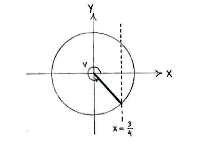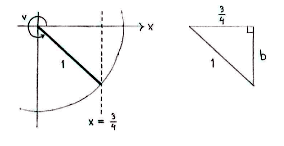Solution 4.3:6a
From Förberedande kurs i matematik 1
(Difference between revisions)
(Ny sida: {{NAVCONTENT_START}} <center> Bild:4_3_6a-1(2).gif </center> {{NAVCONTENT_STOP}} {{NAVCONTENT_START}} <center> Bild:4_3_6a-2(2).gif </center> {{NAVCONTENT_STOP}}) |
m |
||
| (4 intermediate revisions not shown.) | |||
| Line 1: | Line 1: | ||
| - | + | If we think of the angle v as an angle in the unit circle, then ''v'' lies in the fourth quadrant and has ''x''-coordinate 3/4. | |
| - | + | ||
| - | {{ | + | [[Image:4_3_6_a1.gif|center]] |
| - | {{ | + | |
| - | < | + | If we enlarge the fourth quadrant, we see that we can make a right-angled triangle with hypotenuse equal to 1 and an opposite side equal to 3/4. |
| - | {{ | + | |
| + | [[Image:4_3_6_a2.gif|center]] | ||
| + | |||
| + | Using the Pythagorean theorem, it is possible to determine the remaining side from | ||
| + | |||
| + | {{Displayed math||<math>b^2 + \Bigl(\frac{3}{4}\Bigr)^2 = 1^2</math>}} | ||
| + | |||
| + | which gives that | ||
| + | |||
| + | {{Displayed math||<math>b = \sqrt{1-\Bigl(\frac{3}{4}\Bigr)^2} = \sqrt{1-\frac{9}{16}} = \sqrt{\frac{7}{16}} = \frac{\sqrt{7}}{4}\,\textrm{.}</math>}} | ||
| + | |||
| + | Because the angle ''v'' belongs to the fourth quadrant, its ''y''-coordinate is negative and is therefore equal to <math>-b</math>, i.e. | ||
| + | |||
| + | {{Displayed math||<math>\sin v=-\frac{\sqrt{7}}{4}\,\textrm{.}</math>}} | ||
| + | |||
| + | Thus, we have directly that | ||
| + | |||
| + | {{Displayed math||<math>\tan v = \frac{\sin v}{\cos v} = \frac{-\sqrt{7}/4}{3/4} = -\frac{\sqrt{7}}{3}\,\textrm{.}</math>}} | ||
Current revision
If we think of the angle v as an angle in the unit circle, then v lies in the fourth quadrant and has x-coordinate 3/4.
If we enlarge the fourth quadrant, we see that we can make a right-angled triangle with hypotenuse equal to 1 and an opposite side equal to 3/4.
Using the Pythagorean theorem, it is possible to determine the remaining side from
| \displaystyle b^2 + \Bigl(\frac{3}{4}\Bigr)^2 = 1^2 |
which gives that
| \displaystyle b = \sqrt{1-\Bigl(\frac{3}{4}\Bigr)^2} = \sqrt{1-\frac{9}{16}} = \sqrt{\frac{7}{16}} = \frac{\sqrt{7}}{4}\,\textrm{.} |
Because the angle v belongs to the fourth quadrant, its y-coordinate is negative and is therefore equal to \displaystyle -b, i.e.
| \displaystyle \sin v=-\frac{\sqrt{7}}{4}\,\textrm{.} |
Thus, we have directly that
| \displaystyle \tan v = \frac{\sin v}{\cos v} = \frac{-\sqrt{7}/4}{3/4} = -\frac{\sqrt{7}}{3}\,\textrm{.} |


